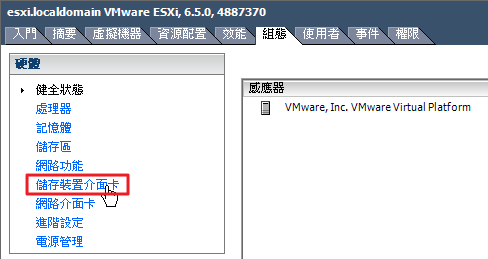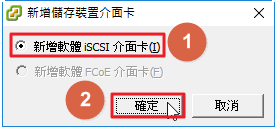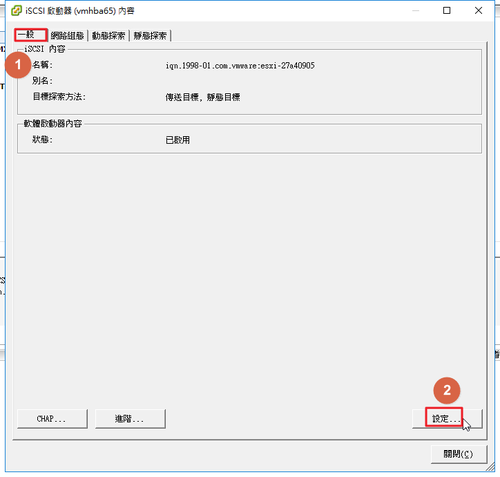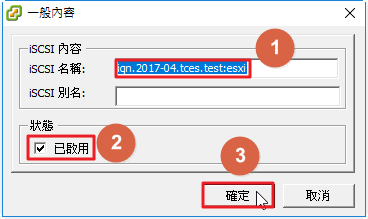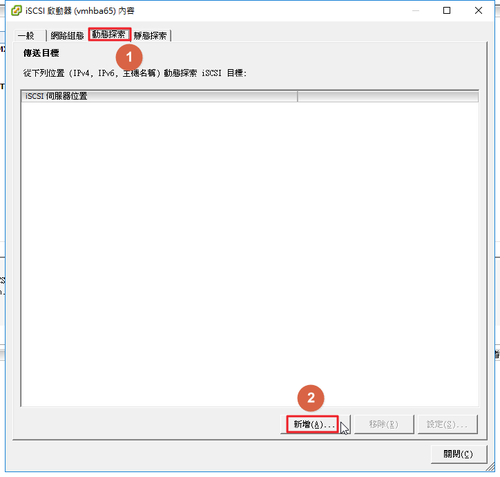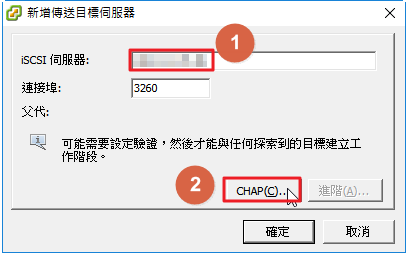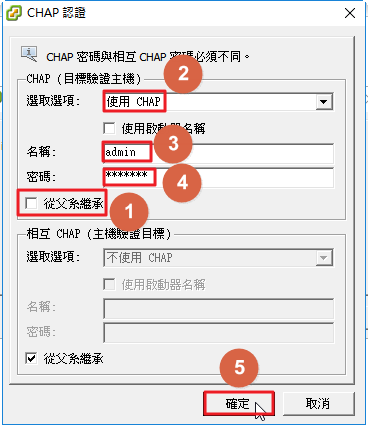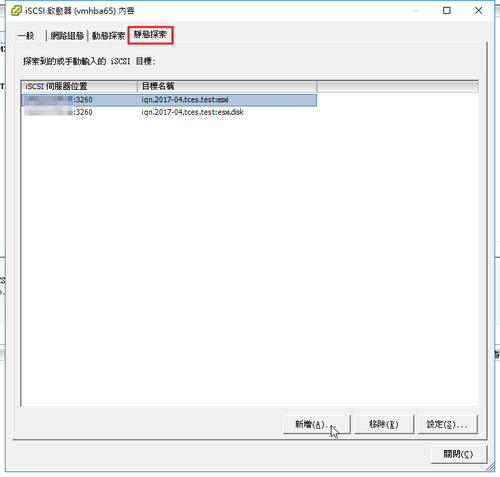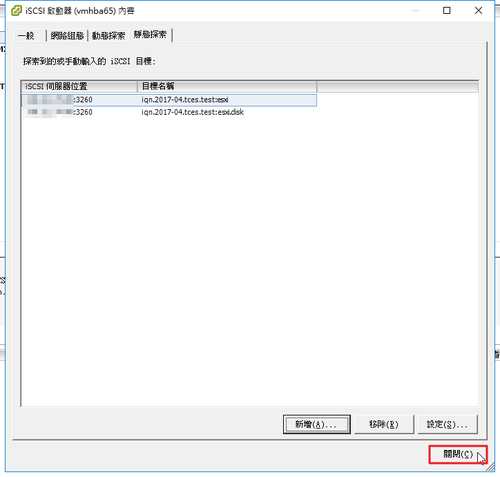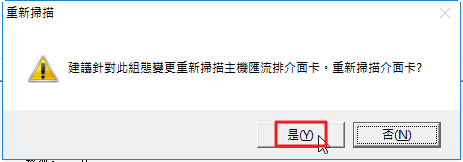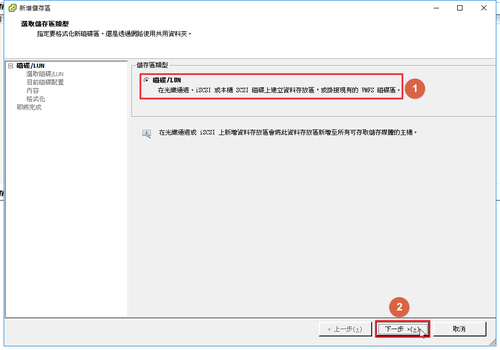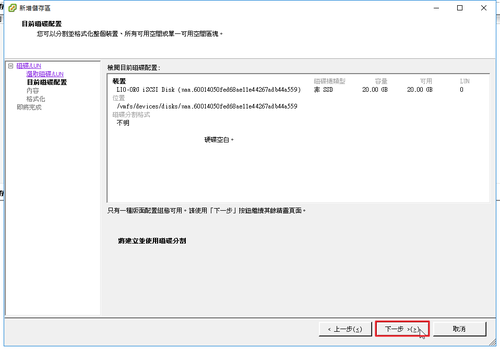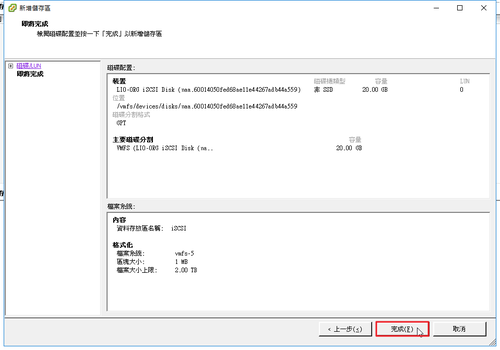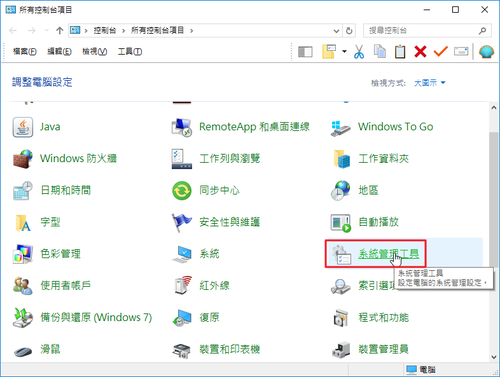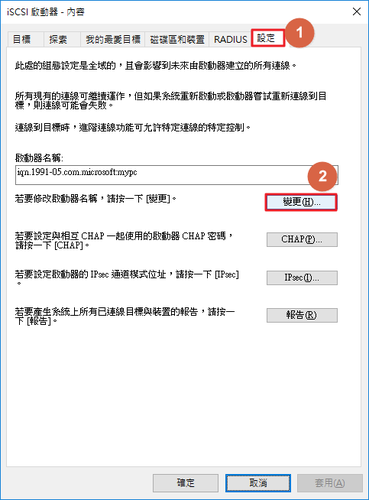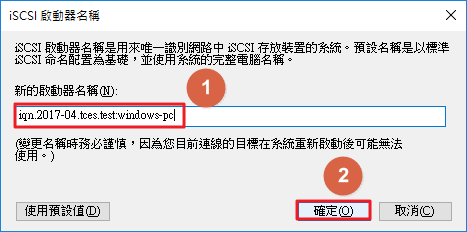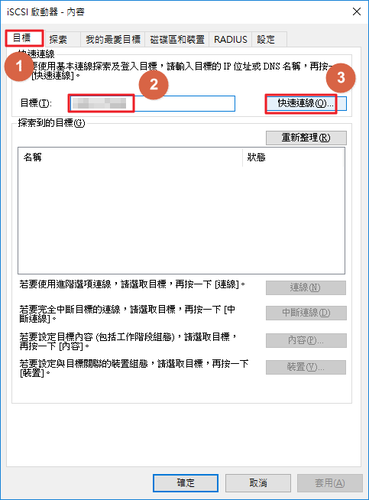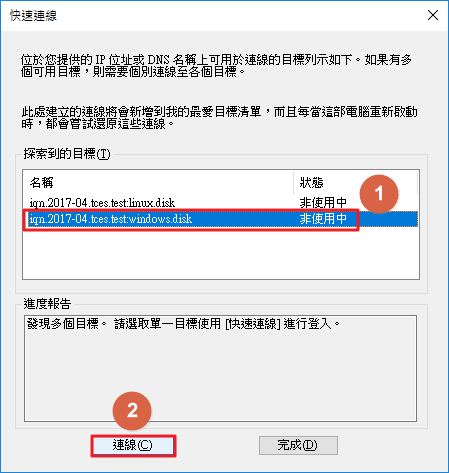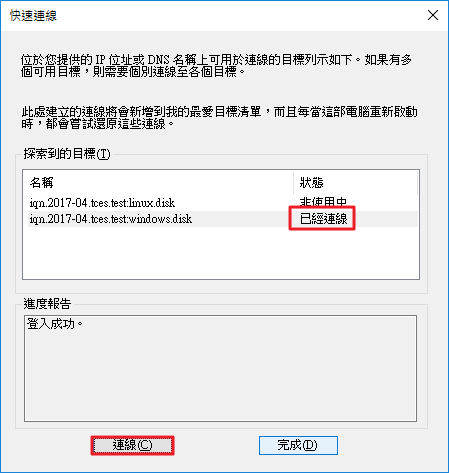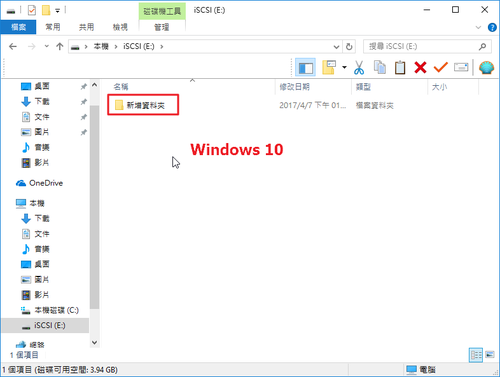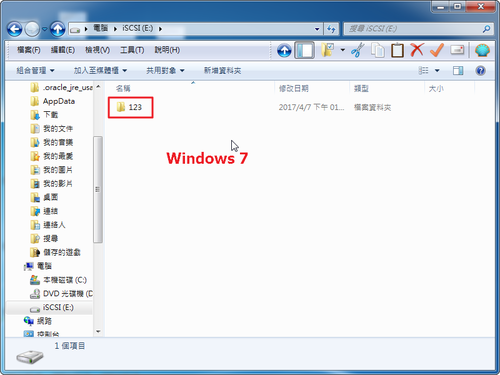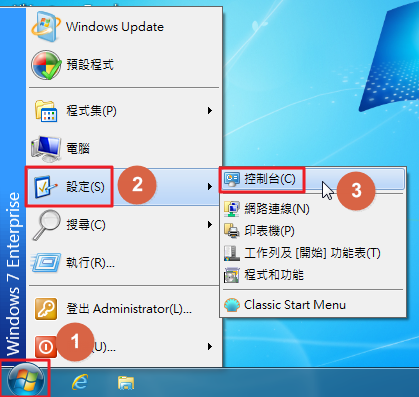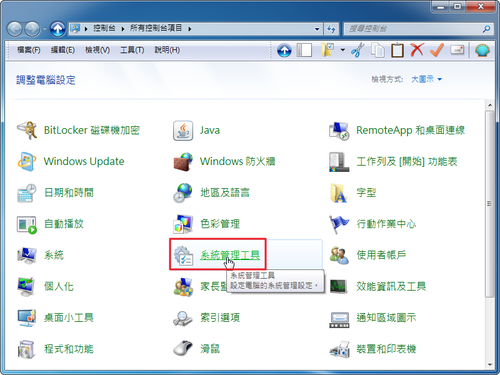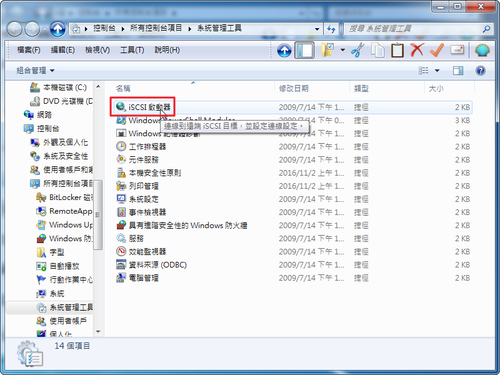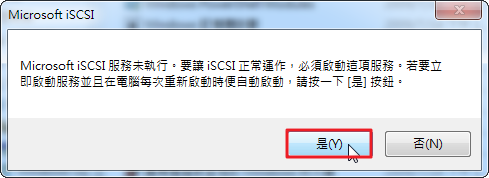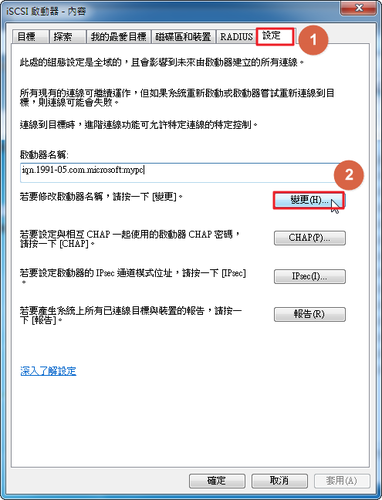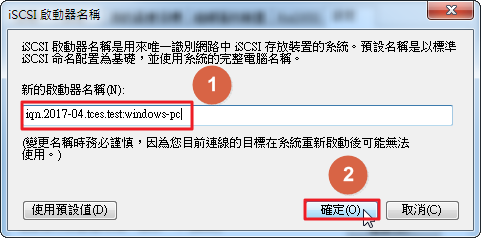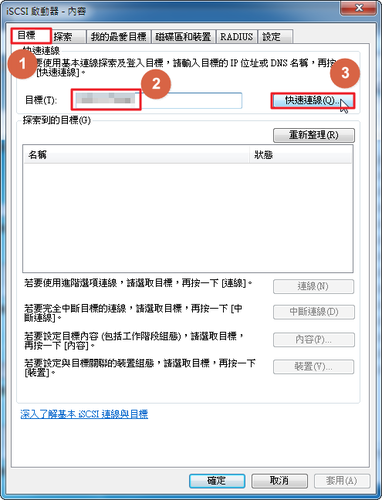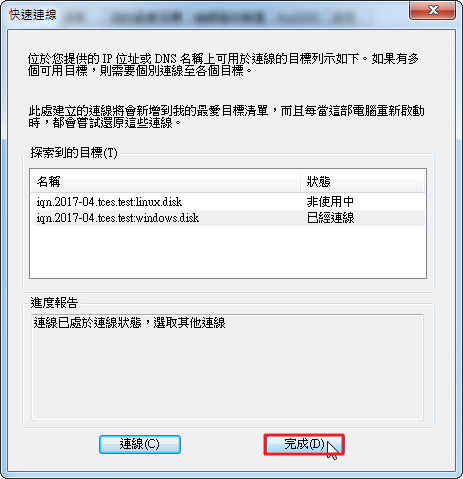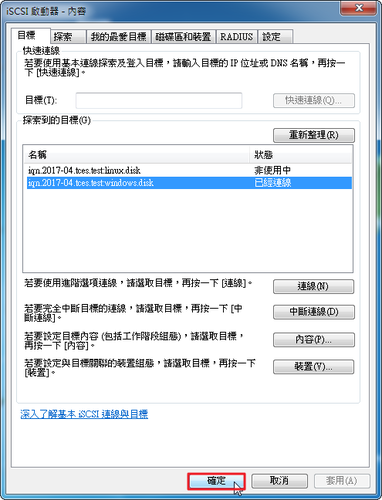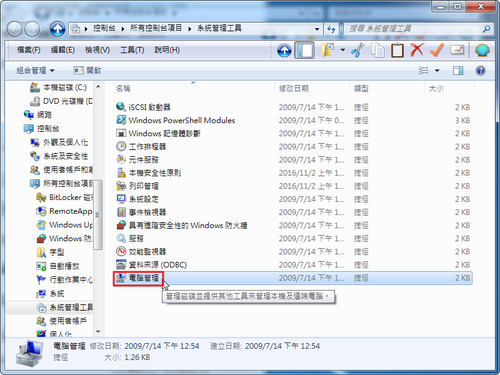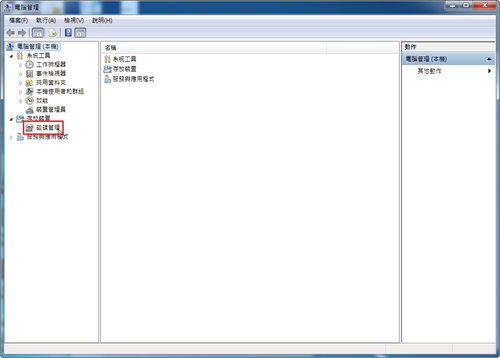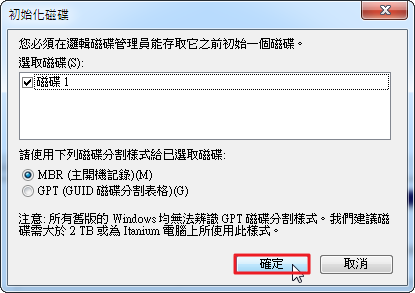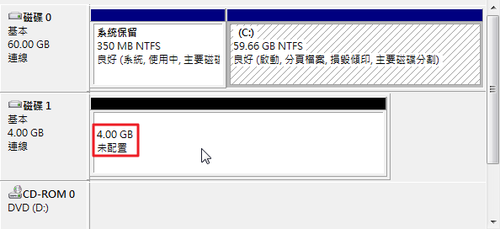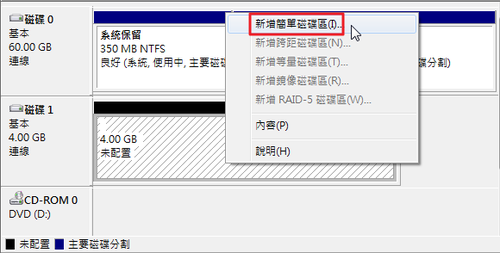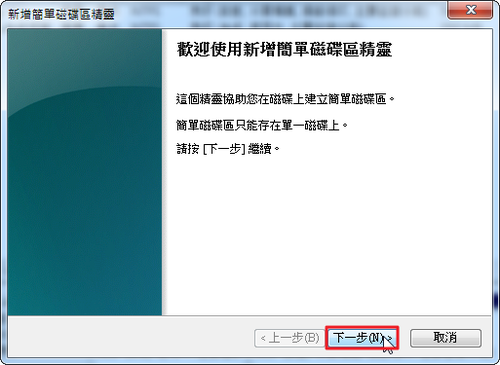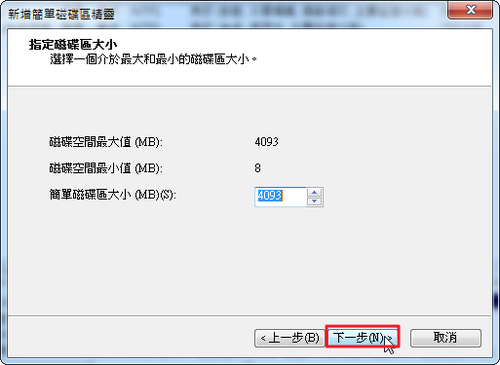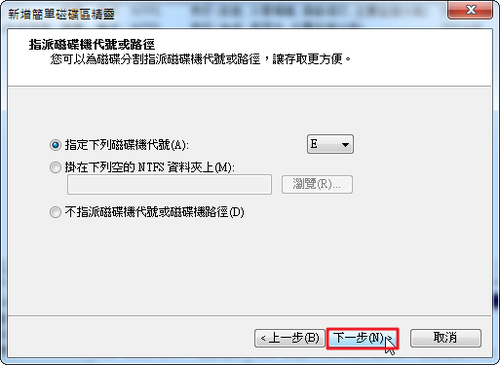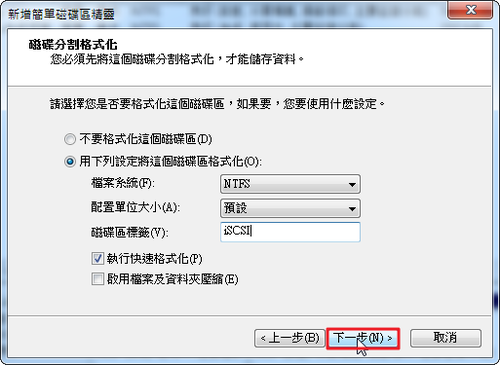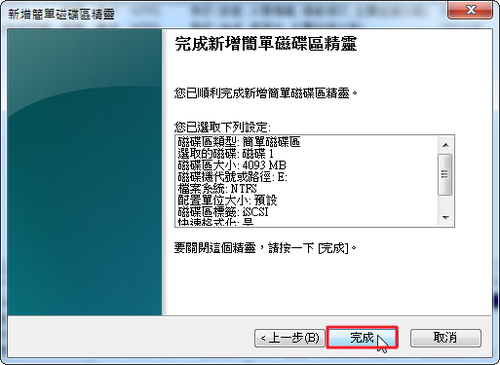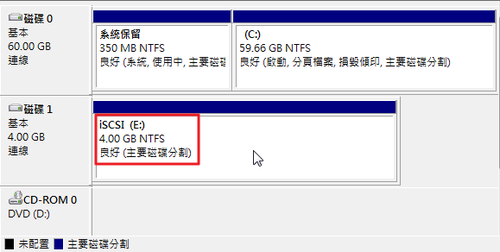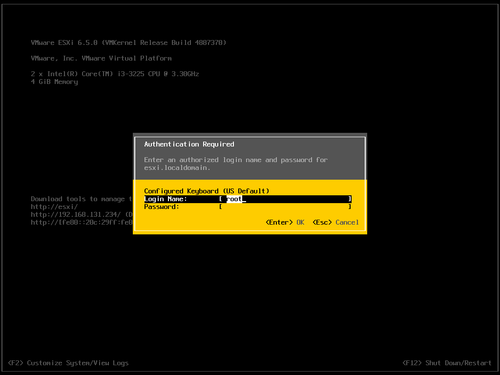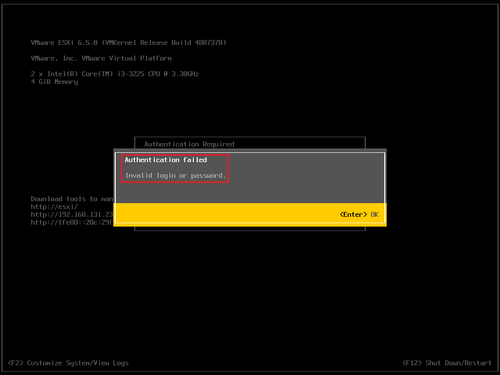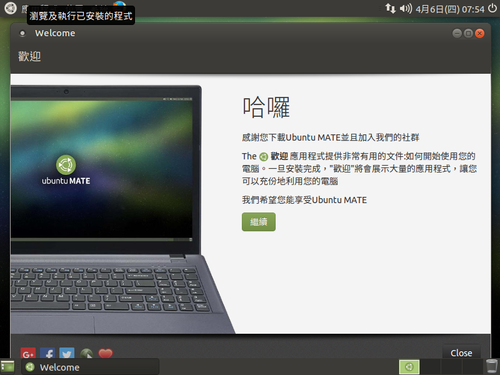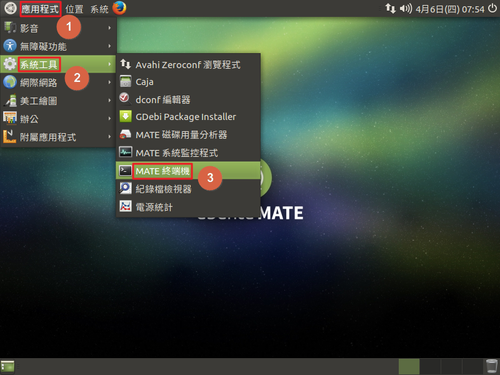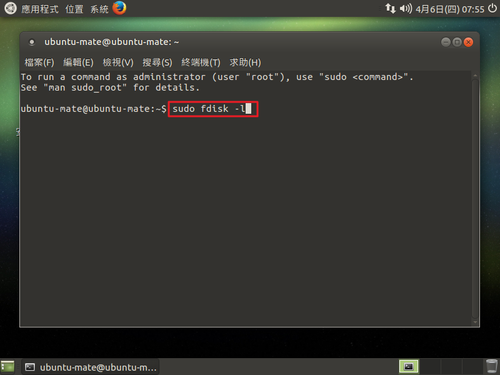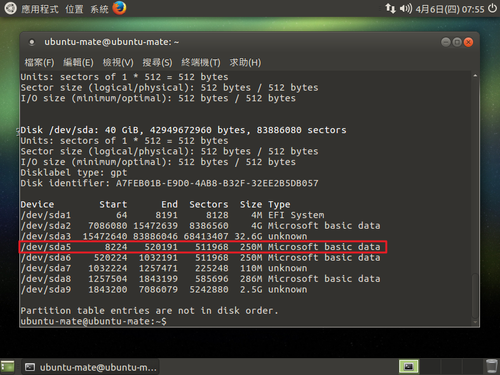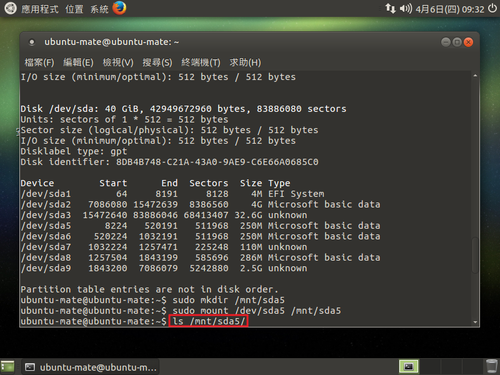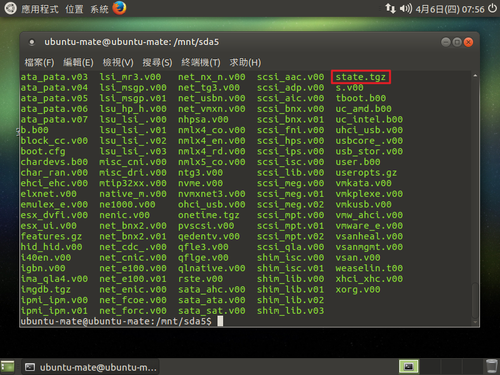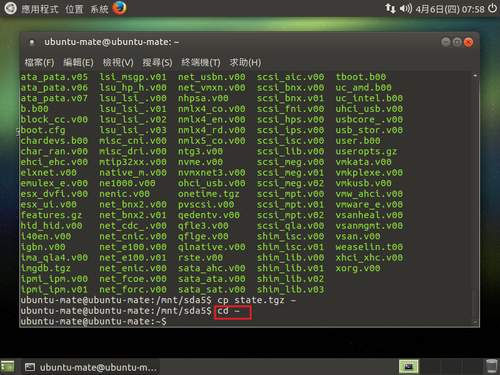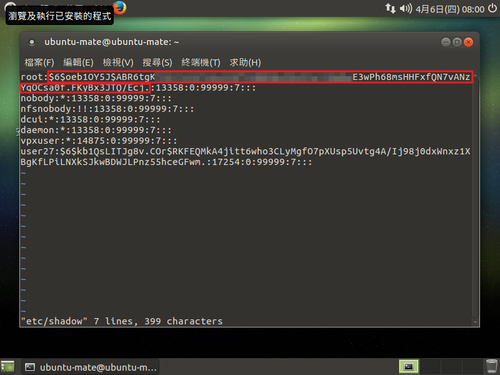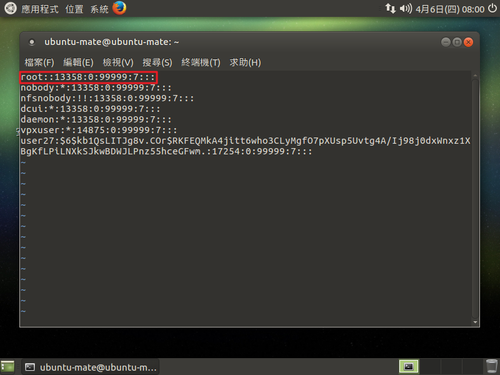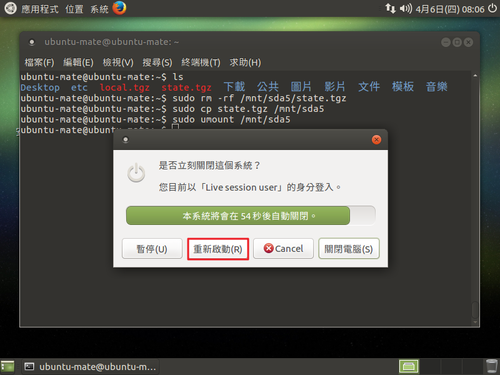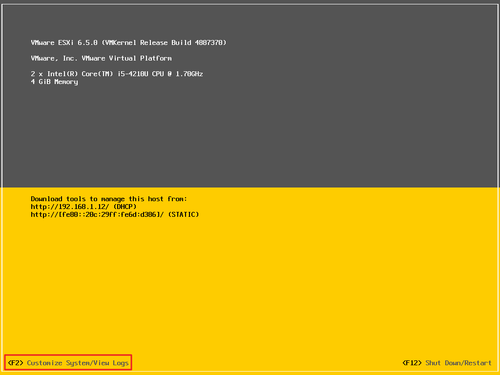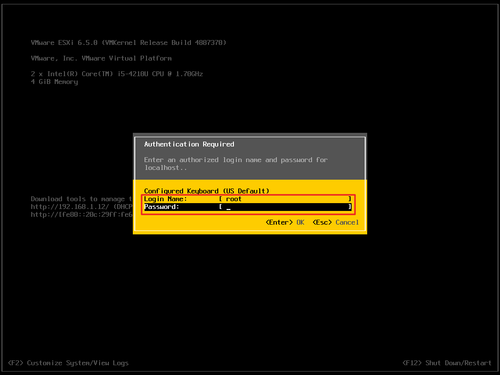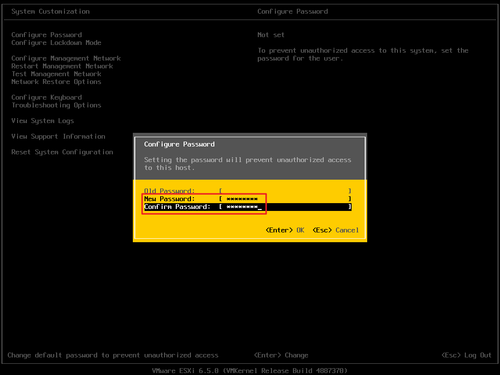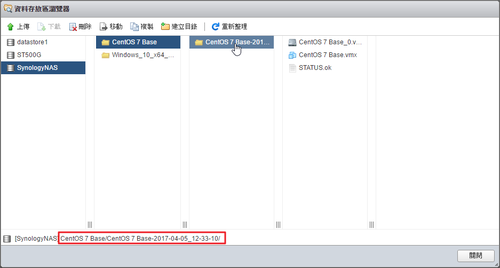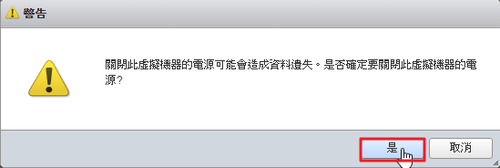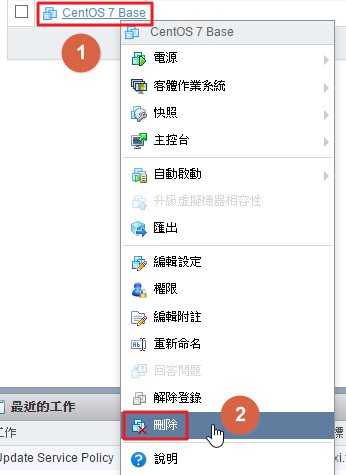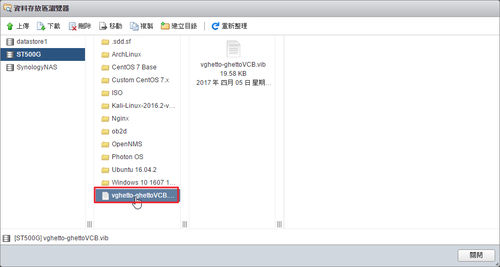Windows 10 連線 iSCSI 設備
Windows 7 連線 iSCSI 設備
在 CentOS 7 下安裝 iSCSI Initiator
參考網站:
CentOS 7 : Configure iSCSI Initiator(CentOS) : Server World
CentOS 7 安裝 iSCSI Server
1. 安裝 iscsi-initiator-utils 套件
# yum -y install iscsi-initiator-utils
2. 修改 /etc/iscsi/initiatorname.iscsi 設定檔
# vim /etc/iscsi/initiatorname.iscsi
InitiatorName=iqn.2017-04.tces.test:linux-pc
3. 修改 /etc/iscsi/iscsid.conf 設定檔
# cp /etc/iscsi/iscsid.conf /etc/iscsi/iscsid.conf.$(date +%F)
# vim /etc/iscsi/iscsid.conf
把
#node.session.auth.authmethod = CHAP
#node.session.auth.username = username
#node.session.auth.password = password
修改成
node.session.auth.authmethod = CHAP
node.session.auth.username = username
node.session.auth.password = password[@more@]
4. 尋找 iSCSI Server 分享的設備
# /usr/sbin/iscsiadm -m discovery -t sendtargets -p 192.168.1.46
192.168.1.46:3260,1 iqn.2017-04.tces.test:linux.disk
5. 顯示 iSCSI Server 狀態
# /usr/sbin/iscsiadm -m node -o show
# BEGIN RECORD 6.2.0.873-35
node.name = iqn.2017-04.tces.test:linux.disk
node.tpgt = 1
node.startup = automatic
node.leading_login = No
iface.hwaddress = <empty>
iface.ipaddress = <empty>
iface.iscsi_ifacename = default
iface.net_ifacename = <empty>
iface.gateway = <empty>
iface.subnet_mask = <empty>
iface.transport_name = tcp
iface.initiatorname = <empty>
iface.state = <empty>
iface.vlan_id = 0
iface.vlan_priority = 0
iface.vlan_state = <empty>
iface.iface_num = 0
iface.mtu = 0
iface.port = 0
iface.bootproto = <empty>
iface.dhcp_alt_client_id_state = <empty>
iface.dhcp_alt_client_id = <empty>
iface.dhcp_dns = <empty>
iface.dhcp_learn_iqn = <empty>
iface.dhcp_req_vendor_id_state = <empty>
iface.dhcp_vendor_id_state = <empty>
iface.dhcp_vendor_id = <empty>
iface.dhcp_slp_da = <empty>
iface.fragmentation = <empty>
iface.gratuitous_arp = <empty>
iface.incoming_forwarding = <empty>
iface.tos_state = <empty>
iface.tos = 0
iface.ttl = 0
iface.delayed_ack = <empty>
iface.tcp_nagle = <empty>
iface.tcp_wsf_state = <empty>
iface.tcp_wsf = 0
iface.tcp_timer_scale = 0
iface.tcp_timestamp = <empty>
iface.redirect = <empty>
iface.def_task_mgmt_timeout = 0
iface.header_digest = <empty>
iface.data_digest = <empty>
iface.immediate_data = <empty>
iface.initial_r2t = <empty>
iface.data_seq_inorder = <empty>
iface.data_pdu_inorder = <empty>
iface.erl = 0
iface.max_receive_data_len = 0
iface.first_burst_len = 0
iface.max_outstanding_r2t = 0
iface.max_burst_len = 0
iface.chap_auth = <empty>
iface.bidi_chap = <empty>
iface.strict_login_compliance = <empty>
iface.discovery_auth = <empty>
iface.discovery_logout = <empty>
node.discovery_address = 140.111.74.46
node.discovery_port = 3260
node.discovery_type = send_targets
node.session.initial_cmdsn = 0
node.session.initial_login_retry_max = 8
node.session.xmit_thread_priority = -20
node.session.cmds_max = 128
node.session.queue_depth = 32
node.session.nr_sessions = 1
node.session.auth.authmethod = CHAP
node.session.auth.username = test
node.session.auth.password = ********
node.session.auth.username_in = <empty>
node.session.auth.password_in = <empty>
node.session.timeo.replacement_timeout = 120
node.session.err_timeo.abort_timeout = 15
node.session.err_timeo.lu_reset_timeout = 30
node.session.err_timeo.tgt_reset_timeout = 30
node.session.err_timeo.host_reset_timeout = 60
node.session.iscsi.FastAbort = Yes
node.session.iscsi.InitialR2T = No
node.session.iscsi.ImmediateData = Yes
node.session.iscsi.FirstBurstLength = 262144
node.session.iscsi.MaxBurstLength = 16776192
node.session.iscsi.DefaultTime2Retain = 0
node.session.iscsi.DefaultTime2Wait = 2
node.session.iscsi.MaxConnections = 1
node.session.iscsi.MaxOutstandingR2T = 1
node.session.iscsi.ERL = 0
node.conn[0].address = 192.168.1.46
node.conn[0].port = 3260
node.conn[0].startup = manual
node.conn[0].tcp.window_size = 524288
node.conn[0].tcp.type_of_service = 0
node.conn[0].timeo.logout_timeout = 15
node.conn[0].timeo.login_timeout = 15
node.conn[0].timeo.auth_timeout = 45
node.conn[0].timeo.noop_out_interval = 5
node.conn[0].timeo.noop_out_timeout = 5
node.conn[0].iscsi.MaxXmitDataSegmentLength = 0
node.conn[0].iscsi.MaxRecvDataSegmentLength = 262144
node.conn[0].iscsi.HeaderDigest = None
node.conn[0].iscsi.IFMarker = No
node.conn[0].iscsi.OFMarker = No
# END RECORD
6. 登入使用 iSCSI 設備
# /usr/sbin/iscsiadm -m node –login
Logging in to [iface: default, target: iqn.2017-04.tces.test:linux.disk, portal: 192.168.1.46,3260] (multiple)
Login to [iface: default, target: iqn.2017-04.tces.test:linux.disk, portal: 192.168.1.46,3260] successful.
7. 顯示連線狀態
# /usr/sbin/iscsiadm -m session -o show
tcp: [1] 192.168.1.46:3260,1 iqn.2017-04.tces.test:linux.disk (non-flash)
8. 檢查是否有多個一個硬碟
# cat /proc/partitions
major minor #blocks name
8 0 20971520 sda
8 1 1048576 sda1
8 2 19921920 sda2
11 0 4277248 sr0
253 0 17821696 dm-0
253 1 2097152 dm-1
8 16 10485760 sdb
# fdisk -l
Disk /dev/sda: 21.5 GB, 21474836480 bytes, 41943040 sectors
Units = sectors of 1 * 512 = 512 bytes
Sector size (logical/physical): 512 bytes / 512 bytes
I/O 大小 (最小/最佳化):512 位元組 / 512 位元組
Disk label type: dos
磁碟識別碼:0x000a2798
所用裝置 開機 開始 結束 區塊 識別號 系統
/dev/sda1 * 2048 2099199 1048576 83 Linux
/dev/sda2 2099200 41943039 19921920 8e Linux LVM
Disk /dev/mapper/cl-root: 18.2 GB, 18249416704 bytes, 35643392 sectors
Units = sectors of 1 * 512 = 512 bytes
Sector size (logical/physical): 512 bytes / 512 bytes
I/O 大小 (最小/最佳化):512 位元組 / 512 位元組
Disk /dev/mapper/cl-swap: 2147 MB, 2147483648 bytes, 4194304 sectors
Units = sectors of 1 * 512 = 512 bytes
Sector size (logical/physical): 512 bytes / 512 bytes
I/O 大小 (最小/最佳化):512 位元組 / 512 位元組
Disk /dev/sdb: 10.7 GB, 10737418240 bytes, 20971520 sectors
Units = sectors of 1 * 512 = 512 bytes
Sector size (logical/physical): 512 bytes / 512 bytes
I/O 大小 (最小/最佳化):512 位元組 / 4194304 位元組
# file /dev/sdb
/dev/sdb: block special
9. 建立掛目錄及格式化硬碟
# mkdir /iscsidisk
# mkfs.xfs /dev/sdb
meta-data=/dev/sdb isize=512 agcount=4, agsize=655360 blks
= sectsz=512 attr=2, projid32bit=1
= crc=1 finobt=0, sparse=0
data = bsize=4096 blocks=2621440, imaxpct=25
= sunit=0 swidth=0 blks
naming =version 2 bsize=4096 ascii-ci=0 ftype=1
log =internal log bsize=4096 blocks=2560, version=2
= sectsz=512 sunit=0 blks, lazy-count=1
realtime =none extsz=4096 blocks=0, rtextents=0
# mount /dev/sdb /iscsidisk
# df -h
檔案系統 容量 已用 可用 已用% 掛載點
/dev/mapper/cl-root 17G 11G 7.0G 60% /
devtmpfs 982M 0 982M 0% /dev
tmpfs 993M 0 993M 0% /dev/shm
tmpfs 993M 8.7M 984M 1% /run
tmpfs 993M 0 993M 0% /sys/fs/cgroup
/dev/sda1 1014M 176M 839M 18% /boot
tmpfs 199M 0 199M 0% /run/user/0
/dev/sdb 10G 33M 10G 1% /iscsidisk
10. 寫入到 /etc/fstab
# blkid | grep /dev/sdb
/dev/sdb: UUID=”8f933fbf-a56d-40bb-8c88-cb9ec851095f” TYPE=”xfs”
# vim /etc/fstab
加入下面一行
/dev/sdb: UUID=8f933fbf-a56d-40bb-8c88-cb9ec851095f /iscsidisk xfs default,_netdev 0 0
在 CentOS 7 下安裝 iSCSI Target
參考網站:
CentOS 7 : Configure iSCSI Target : Server World
CentOS 7 安裝 iSCSI Server
Configure iSCSI Target & Initiator on CentOS 7 / RHEL7
1. 安裝 targetcli 套件
# yum -y install targetcli
2. 建立目錄
# mkdir /iscsi_disks[@more@]
3. 進入 iscsi 管理介面
# /usr/bin/targetcli
Warning: Could not load preferences file /root/.targetcli/prefs.bin.
targetcli shell version 2.1.fb41
Copyright 2011-2013 by Datera, Inc and others.
For help on commands, type ‘help’.
/> cd backstores/fileio
/backstores/fileio> create linux-disk /iscsi_disks/linux-disk.img 10G
Created fileio linux-disk with size 10737418240
/backstores/fileio> cd /iscsi
/iscsi> create iqn.2017-04.tces.test:linux.disk
Created target iqn.2017-04.tces.test:linux.disk.
Created TPG 1.
Global pref auto_add_default_portal=true
Created default portal listening on all IPs (0.0.0.0), port 3260.
/iscsi> cd iqn.2017-04.tces.test:linux.disk/tpg1/luns
/iscsi/iqn.20…isk/tpg1/luns> create /backstores/fileio/linux-disk
Created LUN 0.
/iscsi/iqn.20…isk/tpg1/luns> cd ../acls
/iscsi/iqn.20…isk/tpg1/acls> create iqn.2017-04.tces.test:linux-pc
Created Node ACL for iqn.2017-04.tces.test:linux-pc
Created mapped LUN 0.
/iscsi/iqn.20…isk/tpg1/acls> cd iqn.2017-04.tces.test:linux-pc
/iscsi/iqn.20…test:linux-pc> set auth userid=user
Parameter userid is now ‘user.
/iscsi/iqn.20…test:linux-pc> set auth password=password
Parameter password is now ‘password’.
/iscsi/iqn.20…test:linux-pc> exit
Global pref auto_save_on_exit=true
Last 10 configs saved in /etc/target/backup.
Configuration saved to /etc/target/saveconfig.json
4. 檢查是否有正常執行
# ss -napt | grep 3260
LISTEN 0 256 *:3260 *:*
或
# netstat -napt | grep 3260
tcp 0 0 0.0.0.0:3260 0.0.0.0:* LISTE
5. 防火牆設定
# firewall-cmd –permanent –add-service=iscsi-target
# firewall-cmd –reload
或
# firewall-cmd –permanent –add-port=3260/tcp
# firewall-cmd –reload
或
# iptables -A INPUT -s 192.168.1.0/24 -p tcp -m state –state NEW –dport 3260 -j ACCEPT
For Windows
# /usr/bin/targetcli
Warning: Could not load preferences file /root/.targetcli/prefs.bin.
targetcli shell version 2.1.fb41
Copyright 2011-2013 by Datera, Inc and others.
For help on commands, type ‘help’.
/> cd backstores/fileio
/backstores/fileio> create windows-disk /iscsi_disks/windows-disk.img 4G
Created fileio windows-disk with size 4294967296
/backstores/fileio> cd /iscsi
/iscsi> create iqn.2017-04.tces.test:windows.disk
Created target iqn.2017-04.tces.test:windows.disk.
Created TPG 1.
Global pref auto_add_default_portal=true
Created default portal listening on all IPs (0.0.0.0), port 3260.
/iscsi> cd iqn.2017-04.tces.test:windows.disk/tpg1/luns
/iscsi/iqn.20…isk/tpg1/luns> create /backstores/fileio/windows-disk
Created LUN 0.
/iscsi/iqn.20…isk/tpg1/luns> cd ../acls
/iscsi/iqn.20…isk/tpg1/acls> create iqn.2017-04.tces.test:windows-pc
Created Node ACL for iqn.2017-04.tces.test:windows-pc
Created mapped LUN 0.
/iscsi/iqn.20…isk/tpg1/acls> cd /iscsi/iqn.2017-04.tces.test:windows.disk/tpg1/
/iscsi/iqn.20…ows.disk/tpg1> set attribute authentication=0
Parameter authentication is now ‘0’.
/iscsi/iqn.20…ows.disk/tpg1> cd /iscsi/iqn.2017-04.tces.test:windows.disk/tpg1/
/iscsi/iqn.20…ows.disk/tpg1> set attribute generate_node_acls=0
Parameter generate_node_acls is now ‘0’.
/iscsi/iqn.20…ows.disk/tpg1> exit
Global pref auto_save_on_exit=true
Last 10 configs saved in /etc/target/backup.
Configuration saved to /etc/target/saveconfig.json
Firefox 55.0.2
VMware ESXi – 忘了 root 密碼
參考網頁:
Changing a forgotten root password on an ESX/ESXi host (1317898) | VMware KB
How to Reset Forgotten VMware ESXi Root Password with Ubuntu Live CD
依官方的說法,唯一的方式是重新安裝。
[@more@]解決方式:
1. 找一片 LiveCD,使用 LiveCD 光碟開機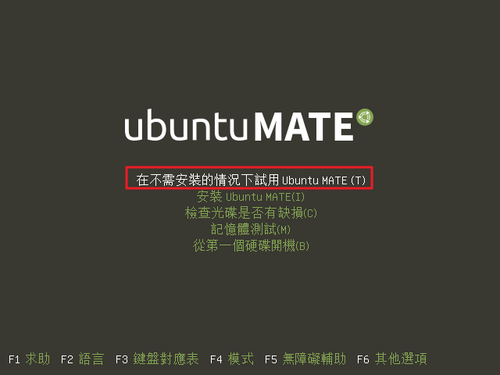
4. 建立掛載目錄
$ sudo mkdir /mnt/sda5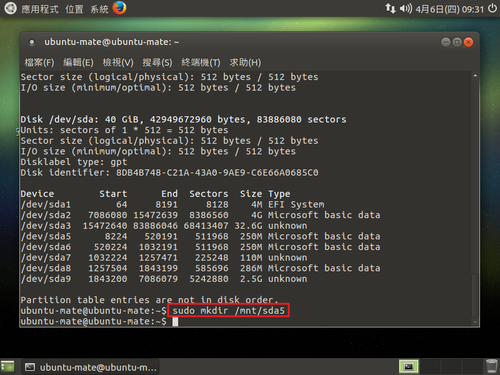
5. 掛載分割區
$ sudo mount /dev/sda5 /mnt/sda5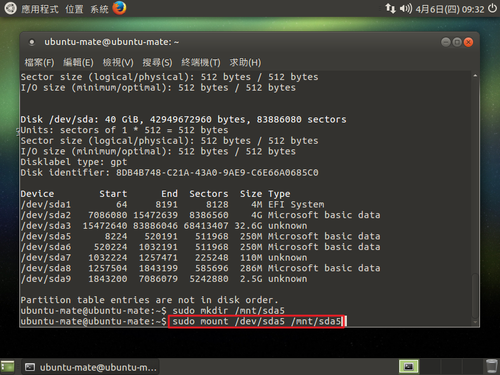
7. 複製檔案到使用者目錄
$ cp /mnt/sda5/state.tgz ~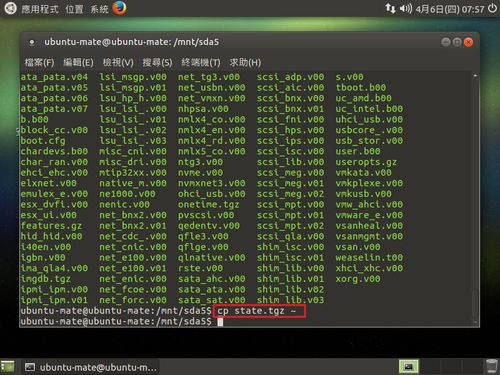
9. 解壓縮
$ tar xvzf state.tgz
$ tar xvzf local.tgz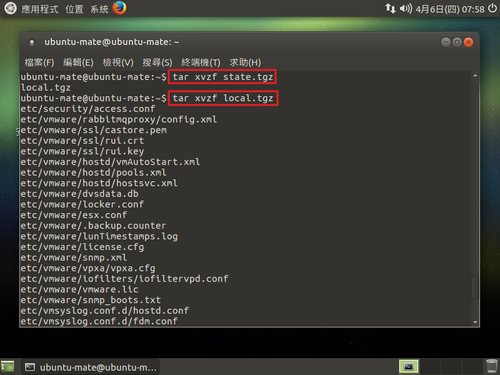
10. 修改 etc/shadow
$ vi etc/shadow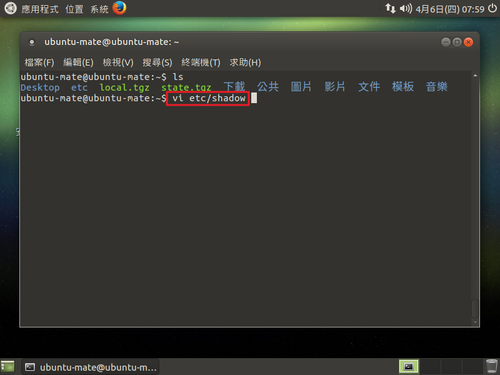
12. 刪除原檔
$ rm -rf local.tgz state.tgz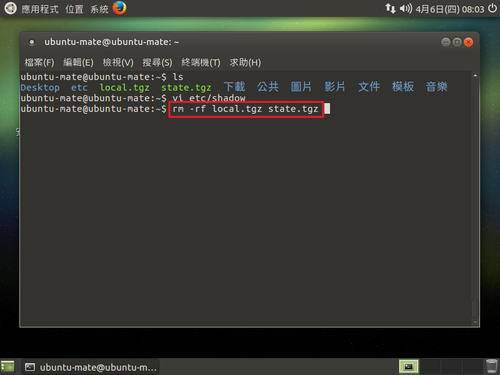
13. 把 etc 目錄壓縮成 local.tgz
$ tar czf local.tgz etc
14. 把 local.tgz 壓縮成 state.tgz
$ tar czf state.tgz local.tgz
15. 刪除原檔
$ sudo rm -rf /mnt/sda5/state.tgz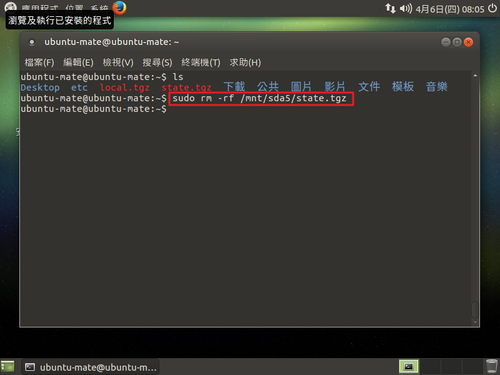
16. 複製修改好的檔案回原目錄
$ sudo cp state.tgz /mnt/sda5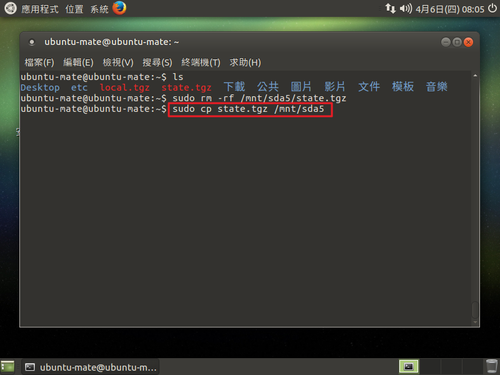
17. 卸載目錄
$ sudo umount /mnt/sda5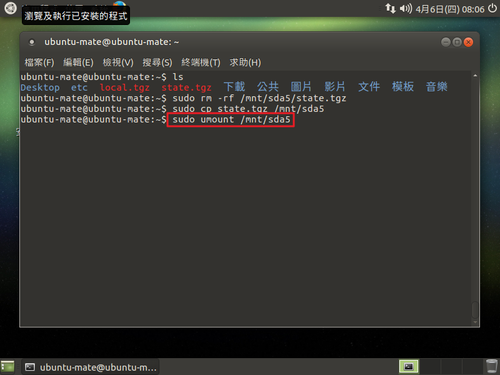
21. 選擇 Configuration Password,可以看出來目前密碼還未設定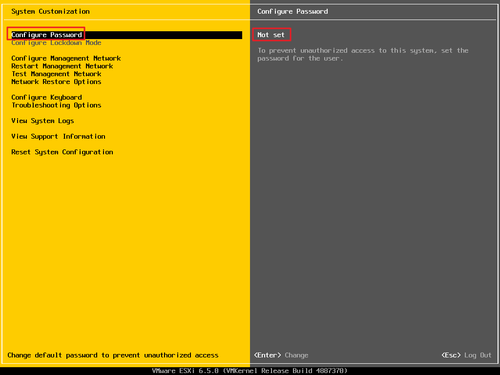
VMware ESXi – ghettoVCB 還原 ESXi 虛擬機器
參考網站:
ghettoVCB 還原 ESXI Guest OS
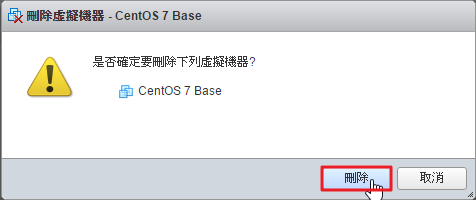 [@more@]
[@more@]
3. 建立要還原的 VM 虛擬機器清單
[root@esxi:~] vi /vmfs/volumes/ST500G/vm_to_restore.lst
# DISK_FORMATS
# 1 = zeroedthick (一次給足全部的硬碟大小,需要時才初使化未使用的空間)
# 2 = 2gbsparse (將硬碟分割成多個 2G 的硬碟)
# 3 = thin (隨著使用量而增加硬碟大小,達到設定上限時就不會在增加)
# 4 = eagerzeroedthick (一次給足全部的硬碟大小,全部初始化可直接使用)
# 格式,以 ; 做分隔
# “VM 備份檔所在的完整路徑;還原後的 VM 要存放的完整路徑;還原時硬碟的格式”
“/vmfs/volumes/SynologyNAS/CentOS 7 Base/CentOS 7 Base-2017-04-05_12-33-10;/vmfs/volumes/ST500G;3”
4. 進行復原
[root@esxi:~] /opt/ghettovcb/bin/ghettoVCB-restore.sh -c /vmfs/volumes/ST500G/vm_to_restore.lst -l /vmfs/volumes/ST500G/ghettoVCB_log/ghettoVCB-restore.$(date +%F)
################## Restoring VM: CentOS 7 Base #####################
Start time: Wed Apr 5 23:40:28 CST 2017
Restoring VM from: “/vmfs/volumes/SynologyNAS/CentOS 7 Base/CentOS 7 Base-2017-04-05_12-33-10”
Restoring VM to Datastore: “/vmfs/volumes/ST500G” using Disk Format: “thin”
Creating VM directory: “/vmfs/volumes/ST500G/CentOS 7 Base” …
Copying “CentOS 7 Base.vmx” file …
Restoring VM’s VMDK(s) …
Updating VMDK entry in “CentOS 7 Base.vmx” file …
Option –adaptertype is deprecated and hence will be ignored
Destination disk format: VMFS thin-provisioned
Cloning disk ‘/vmfs/volumes/SynologyNAS/CentOS 7 Base/CentOS 7 Base-2017-04-05_12-33-10/CentOS 7 Base_0.vmdk’…
Clone: 100% done.
Registering CentOS 7 Base …
33
End time: Thu Apr 6 00:04:58 CST 2017
################## Completed restore for CentOS 7 Base! #####################
Start time: Wed Apr 5 23:40:28 CST 2017
End time: Thu Apr 6 00:04:58 CST 2017
Duration : 24.50 Minutes
—————————————————————————————————————
5. 更多 ghettoVCB-restore.sh 指令用法
[root@esxi:~] /opt/ghettovcb/bin/ghettoVCB-restore.sh
###############################################################################
#
# ghettoVCB-restore for ESX/ESXi 3.5, 4.x, 5.x & 6.x
# Author: William Lam
# http://www.virtuallyghetto.com/
# Documentation: http://communities.vmware.com/docs/DOC-8760
# Created: 08/18/2009
# Last modified: 2015_04_04_1
#
###############################################################################
Usage: /opt/ghettovcb/bin/ghettoVCB-restore.sh -c [VM_BACKUP_UP_LIST] -l [LOG_FILE] -d [DRYRUN_DEBUG_INFO]
OPTIONS:
-c VM backup list
-l File ot output logging
-d Dryrun/Debug Info [1|2]
(e.g.)
Output will go to stdout
/opt/ghettovcb/bin/ghettoVCB-restore.sh -c vms_to_restore
Output will log to /tmp/ghettoVCB-restore.log
/opt/ghettovcb/bin/ghettoVCB-restore.sh -c vms_to_restore -l /tmp/ghettoVCB-restore.log
Dryrun/Debug Info (dryrun only)
/opt/ghettovcb/bin/ghettoVCB-restore.sh -c vms_to_restore -d 1
/opt/ghettovcb/bin/ghettoVCB-restore.sh -c vms_to_restore -d 2
VMware ESXi – ghettoVCB 排程備份
1. 備份 /var/spool/cron/crontabs/root 到 /vmfs/volumes/ST500G/crontabsroot
[root@esxi:~] cp /var/spool/cron/crontabs/root /vmfs/volumes/ST500G/crontabsroot
2. 進行修改
[root@esxi:~] cat /vmfs/volumes/ST500G/crontabsroot
#min hour day mon dow command
1 1 * * * /sbin/tmpwatch.py
1 * * * * /sbin/auto-backup.sh
0 * * * * /usr/lib/vmware/vmksummary/log-heartbeat.py
*/5 * * * * /bin/hostd-probe.sh ++group=host/vim/vmvisor/hostd-probe/stats/sh
00 1 * * * localcli storage core device purge
30 1 * * * /opt/ghettovcb/bin/ghettoVCB.sh -g /opt/ghettovcb/ghettoVCB.conf -f /vmfs/volumes/ST500G/ghetto.lst > /dev/null 2>&1[@more@]
3. 建立 /vmfs/volumes/ST500G/crondtab.sh
[root@esxi:~] vi /vmfs/volumes/ST500G/crondtab.sh
#!/bin/sh
#add backup crond shell
/bin/kill $(cat /var/run/crond.pid)
cp /vmfs/volumes/ST500G/crontabsroot /var/spool/cron/crontabs/root
/usr/lib/vmware/busybox/bin/busybox crond
4. 更改檔案權限
[root@esxi:~] chmod 755 /vmfs/volumes/ST500G/crondtab.sh
5. 將 crondtab.sh 加入開機設定檔 /etc/rc.local.d/local.sh
[root@esxi:~] vi /etc/rc.local.d/local.sh
#backup crond
/vmfs/volumes/ST500G/crondtab.sh
# 時區設定
if [ -e /etc/localtime ];then
rm -rf /etc/localtime
cp /vmfs/volumes/ST500G/localtime /etc
else
cp /vmfs/volumes/ST500G/localtime /etc
fi
VMware ESXi – ghettoVCB 備份 ESXi 虛擬機器
參考網站:
ghettoVCB 備份 ESXI Guest OS
ESXi 5.1 / 5.5 定期排程備份線上VM;NFS、sendmail-ghettoVCB | Mr. 沙先生
Backing up VMware ESXi VMs with ghettoVCB – Miscellaneous Knowledge
虛擬機器不用先關機,ghettoVCB.sh 會先為虛擬機器建立快照,然後進行備份,當備份完成之後會刪除快照。
1.下載 ghettoVCB
3. 開啟 ESXi 伺服器可安裝非原廠的額外套件
[root@esxi:~] esxcli software acceptance set –level=CommunitySupported
Host acceptance level changed to ‘CommunitySupported’.
4. 進行安裝 ghettoVCB,似乎沒有進行第 3 步驟,也可以進行安裝
[root@esxi:~] esxcli software vib install -v /vmfs/volumes/ST500G/vghetto-ghettoVCB.vib -f
Installation Result
Message: Operation finished successfully.
Reboot Required: false
VIBs Installed: virtuallyGhetto_bootbank_ghettoVCB_1.0.0-0.0.0
VIBs Removed:
VIBs Skipped:
檔案安裝位置
[root@esxi:~] ls -l /opt/ghettovcb/bin/*
-r-xr-xr-x 1 root root 17555 Jan 11 14:31 /opt/ghettovcb/bin/ghettoVCB-restore.sh
-r-xr-xr-x 1 root root 65458 Jan 11 14:31 /opt/ghettovcb/bin/ghettoVCB.sh[@more@]
5. 建立 ghettoVCB.conf 設定檔
[root@esxi:~] vi /opt/ghettoVCB/ghettoVCB.conf
# 備份到 SynologyNAS
VM_BACKUP_VOLUME=/vmfs/volumes/SynologyNAS
# 備份虛擬機格式,採用精簡建
DISK_BACKUP_FORMAT=thin
# 定義備份保留的數量
VM_BACKUP_ROTATION_COUNT=3
# 虛擬機器 POWER OFF 時不會要求 snapshottting
POWER_VM_DOWN_BEFORE_BACKUP=0
# 定義沒有安裝 VMware Tools 的虛擬機器是否可以在硬碟 POWER OFF 時啟用
ENABLE_HARD_POWER_OFF=0
# 如果啟用 ENABLE_HARD_POWER_OFF,將強制執行關閉時會侄數運算,時間是 3 分鐘
ITER_TO_WAIT_SHUTDOWN=3
# 設定 POWER DOWN 的時間,等待關閉時,VM 會放棄或忽略特定的 VM 備份。時間是 5 分鐘
POWER_DOWN_TIMEOUT=5
# 不進行壓縮
ENABLE_COMPRESSION=0
# 不啟用 VM 虛擬機器的快照記憶體
VM_SNAPSHOT_MEMORY=0
# 不啟用對停止的 VM 虛擬機器使用快照(需要有安裝 VMware Tools)
VM_SNAPSHOT_QUIESCE=0
ALLOW_VMS_WITH_SNAPSHOTS_TO_BE_BACKEDUP=0
# 開啟 NFS
ENABLE_NON_PERSISTENT_NFS=1
# 執行完畢就 unmount
UNMOUNT_NFS=0
# NFS Server IP
NFS_SERVER=xxx.xxx.xxx.xxx
# NFS 版本
NFS_VERSION=nfs
# NFS Host 掛載目錄
NFS_MOUNT=/volume1/homes/test/Server/esxi
NFS_LOCAL_NAME=SynologyNAS
NFS_VM_BACKUP_DIR=mybackups
6. 建立 log 檔存放目錄
[root@esxi:~] mkdir /vmfs/volumes/ST500G/ghettoVCB_log
7. 修改 /opt/ghettovcb/bin/ghettoVCB.sh
[root@esxi:~] vi /opt/ghettovcb/bin/ghettoVCB.sh
找到
#if no logfile then provide default logfile in /tmp
if [[ -z “${LOG_OUTPUT}” ]] ; then
LOG_OUTPUT=”/tmp/ghettoVCB-$(date +%F_%H-%M-%S)-$$.log”
echo “Logging output to “${LOG_OUTPUT}” …”
fi
修改成
#if no logfile then provide default logfile in /tmp
if [[ -z “${LOG_OUTPUT}” ]] ; then
LOG_OUTPUT=”//vmfs/volumes/ST500G/ghettoVCB_log/ghettoVCB-$(date +%F_%H-%M-%S)-$$.log”
echo “Logging output to “${LOG_OUTPUT}” …”
fi
8. 列出安裝的虛擬機器
[root@esxi:~] vim-cmd vmsvc/getallvms
Vmid Name File Guest OS Version Annotation
1 OB2D Linux 2017 1.0 [ST500G] ob2d/ob2d.vmx other26xLinux64Guest vmx-13
2 Custom CentOS 7.x [ST500G] Custom CentOS 7.x/Custom CentOS 7.x.vmx centos7_64Guest vmx-13
21 OpenNMS [ST500G] OpenNMS/OpenNMS.vmx centos7_64Guest vmx-13
22 Nginx [ST500G] Nginx/Nginx.vmx centos7_64Guest vmx-13
24 Ubuntu 16.04.2 [ST500G] Ubuntu 16.04.2/Ubuntu 16.04.2.vmx ubuntu64Guest vmx-13
25 ArchLinux [ST500G] ArchLinux/ArchLinux.vmx other26xLinux64Guest vmx-13
26 Windows 10 1607 14393.0 [ST500G] Windows 10 1607 14393.969/Windows 10 1607 14393.969.vmx windows9_64Guest vmx-13
31 Photon OS [ST500G] Photon OS/Photon OS.vmx other3xLinux64Guest vmx-13
32 CentOS 7 Base [ST500G] CentOS 7 Base/CentOS 7 Base.vmx centos7_64Guest vmx-13
9. 進行備份
備份 CentOS 7 Base
[root@esxi:~] /opt/ghettovcb/bin/ghettoVCB.sh -g /opt/ghettovcb/ghettoVCB.conf -m “CentOS 7 Base” -l /vmfs/volumes/ST500G/ghettoVCB_log/ghettoVCB-backup.$(date +%F)
備份全部
[root@esxi:~] /opt/ghettovcb/bin/ghettoVCB.sh -g /opt/ghettovcb/ghettoVCB.conf -a -l /vmfs/volumes/ST500G/ghettoVCB_log/ghettoVCB-backup.$(date +%F)
備份清單
[root@esxi:~] cat /vmfs/volumes/ST500G/vm_to_backup.lst
OpenNMS
Nginx
ArchLinux
[root@esxi:~] /opt/ghettovcb/bin/ghettoVCB.sh -g /opt/ghettovcb/ghettoVCB.conf -f /vmfs/volumes/ST500G/vm_to_backup.lst -l /vmfs/volumes/ST500G/ghettoVCB_log/ghettoVCB-backup.$(date +%F)
10. ghettoVCB.sh 指令用法
[root@esxi:~] /opt/ghettovcb/bin/ghettoVCB.sh
###############################################################################
#
# ghettoVCB for ESX/ESXi 3.5, 4.x+, 5.x & 6.x
# Author: William Lam
# http://www.virtuallyghetto.com/
# Documentation: http://communities.vmware.com/docs/DOC-8760
# Created: 11/17/2008
# Last modified: 2016_11_20 Version 1
#
###############################################################################
Usage: ghettoVCB.sh [options]
OPTIONS:
-a Backup all VMs on host(備份所有的 VM)
-f List of VMs to backup(備份清單中的 VM,一行一個 VM)
-m Name of VM to backup (overrides -f)(備份 VM)
-c VM configuration directory for VM backups
-g Path to global ghettoVCB configuration file(ghettoVCB.conf 設定檔位置)
-l File to output logging(log 檔位置)
-w ghettoVCB work directory (default: /tmp/ghettoVCB.work)
-d Debug level [info|debug|dryrun] (default: info)
(e.g.)
Backup VMs stored in a list
/opt/ghettovcb/bin/ghettoVCB.sh -f vms_to_backup
Backup a single VM
/opt/ghettovcb/bin/ghettoVCB.sh -m vm_to_backup
Backup all VMs residing on this host
/opt/ghettovcb/bin/ghettoVCB.sh -a
Backup all VMs residing on this host except for the VMs in the exclusion list
/opt/ghettovcb/bin/ghettoVCB.sh -a -e vm_exclusion_list
Backup VMs based on specific configuration located in directory
/opt/ghettovcb/bin/ghettoVCB.sh -f vms_to_backup -c vm_backup_configs
Backup VMs using global ghettoVCB configuration file
/opt/ghettovcb/bin/ghettoVCB.sh -f vms_to_backup -g /global/ghettoVCB.conf
Output will log to /tmp/ghettoVCB.log (consider logging to local or remote datastore to persist logs)
/opt/ghettovcb/bin/ghettoVCB.sh -f vms_to_backup -l /vmfs/volume/local-storage/ghettoVCB.log
Dry run (no backup will take place)
/opt/ghettovcb/bin/ghettoVCB.sh -f vms_to_backup -d dryrun


